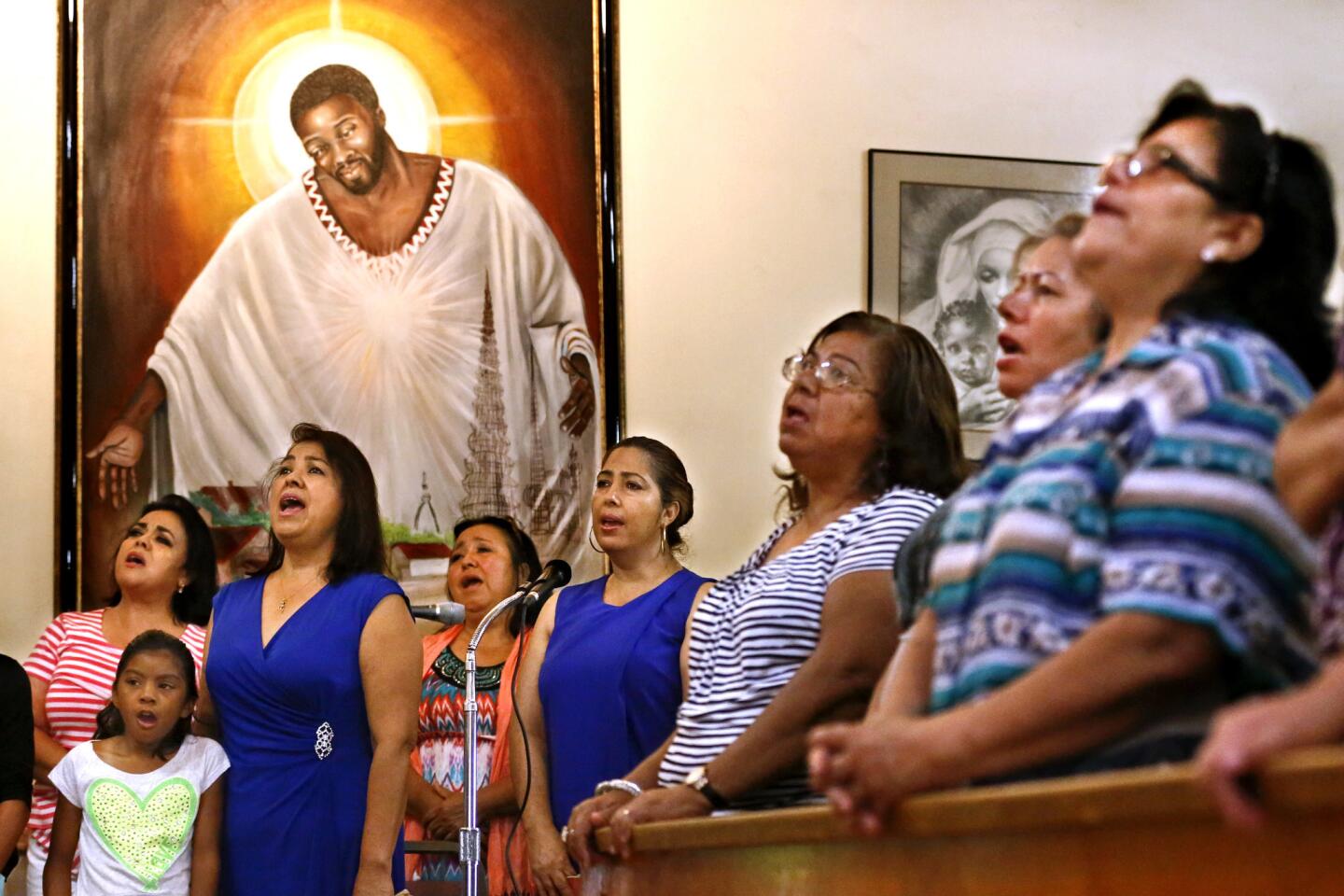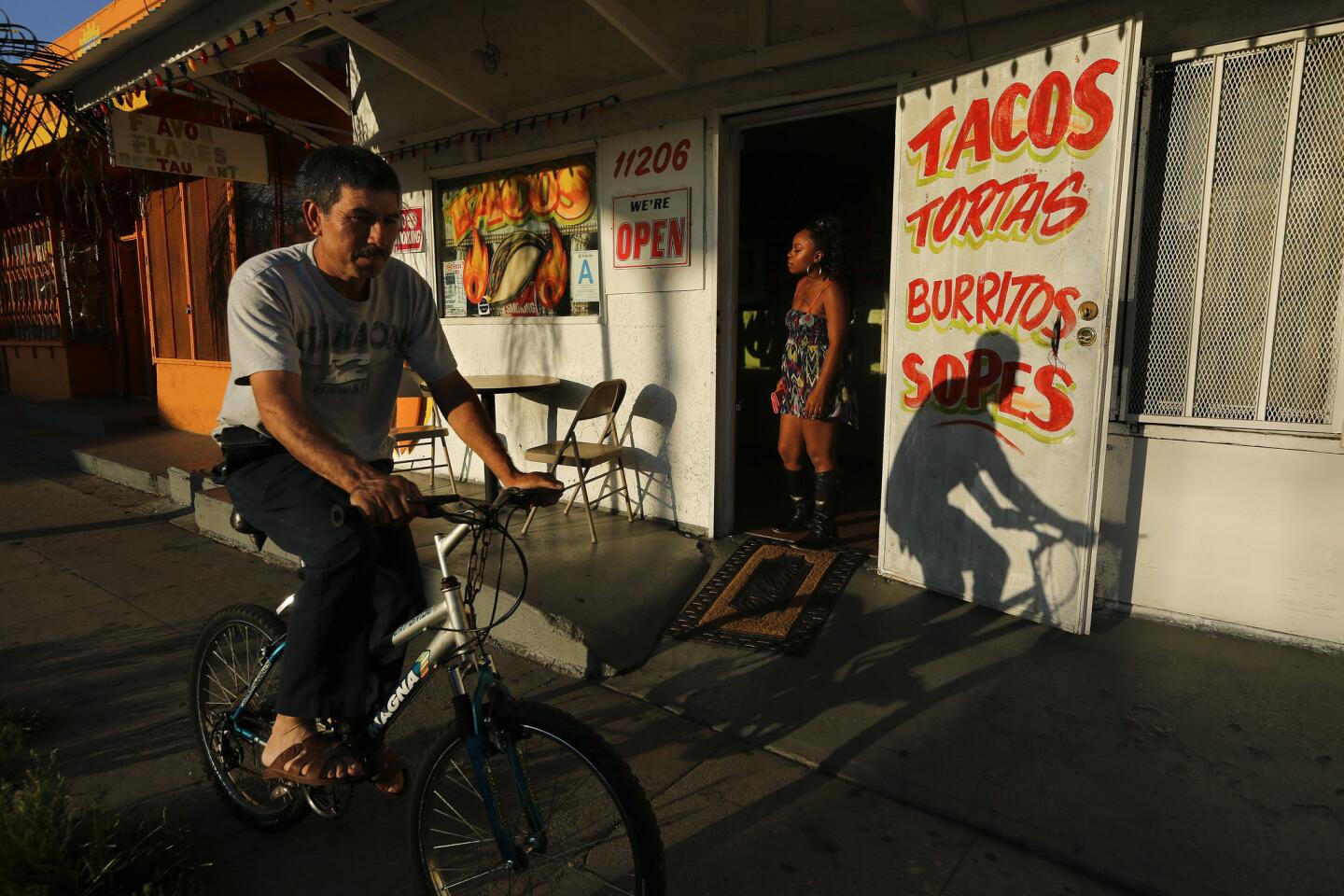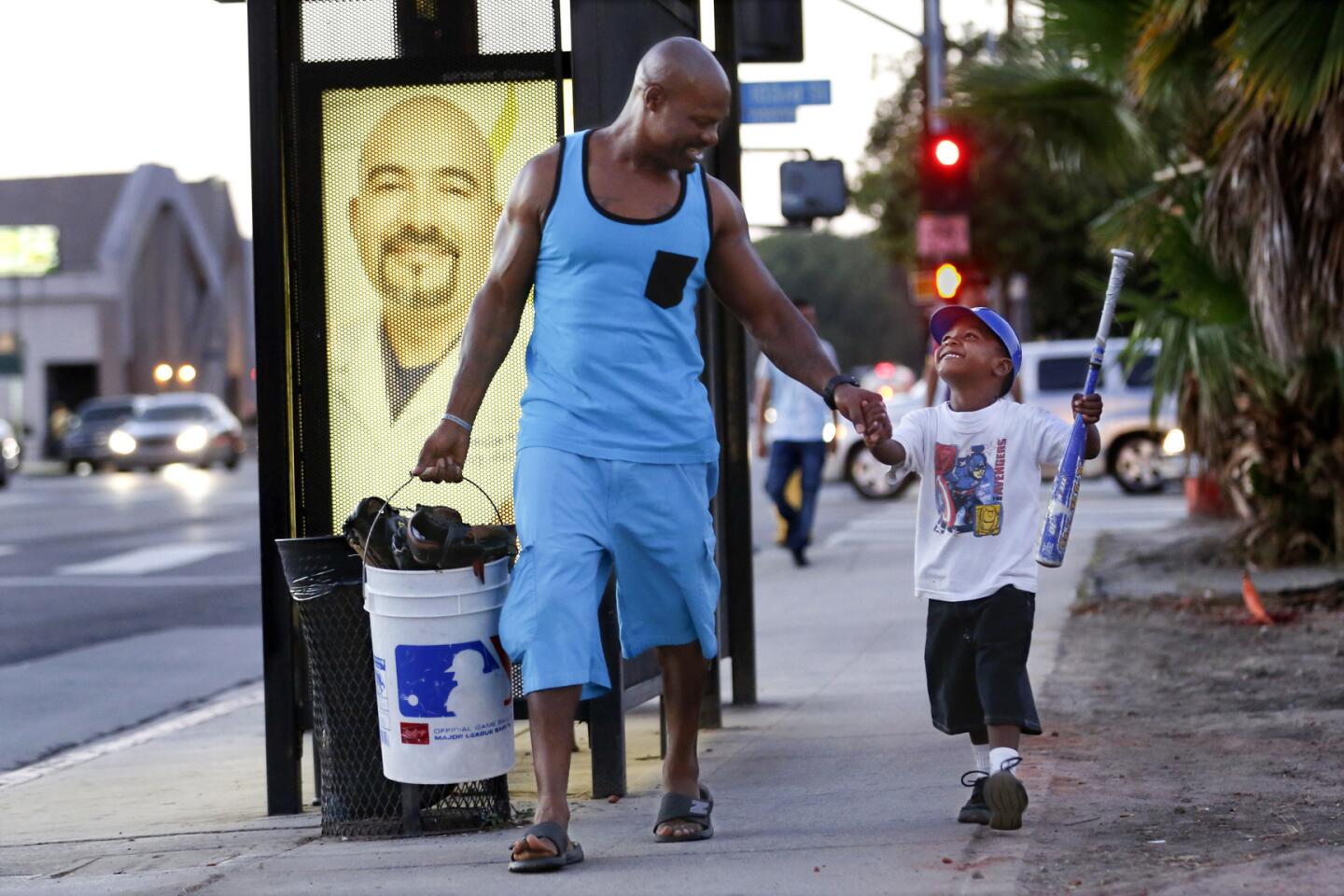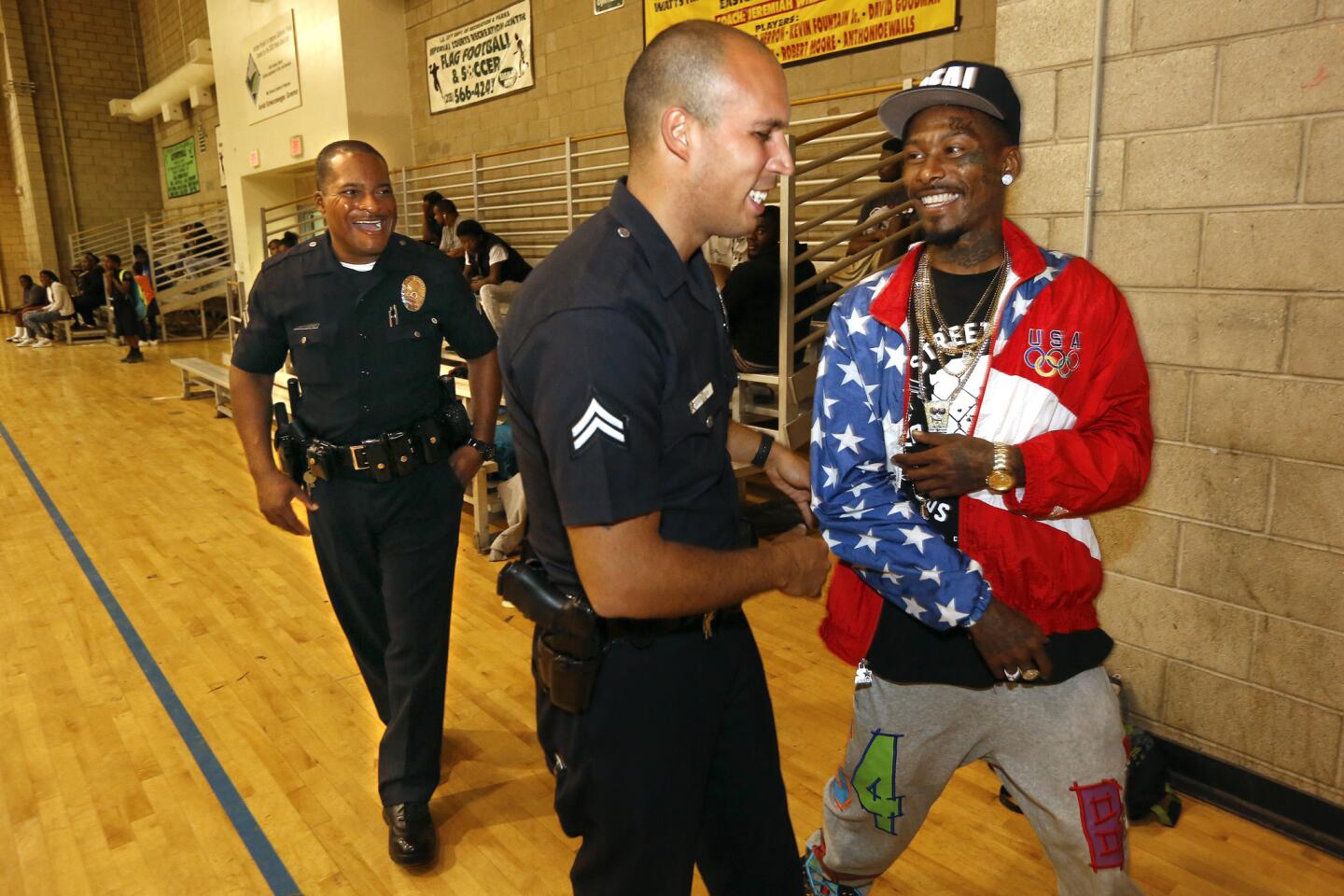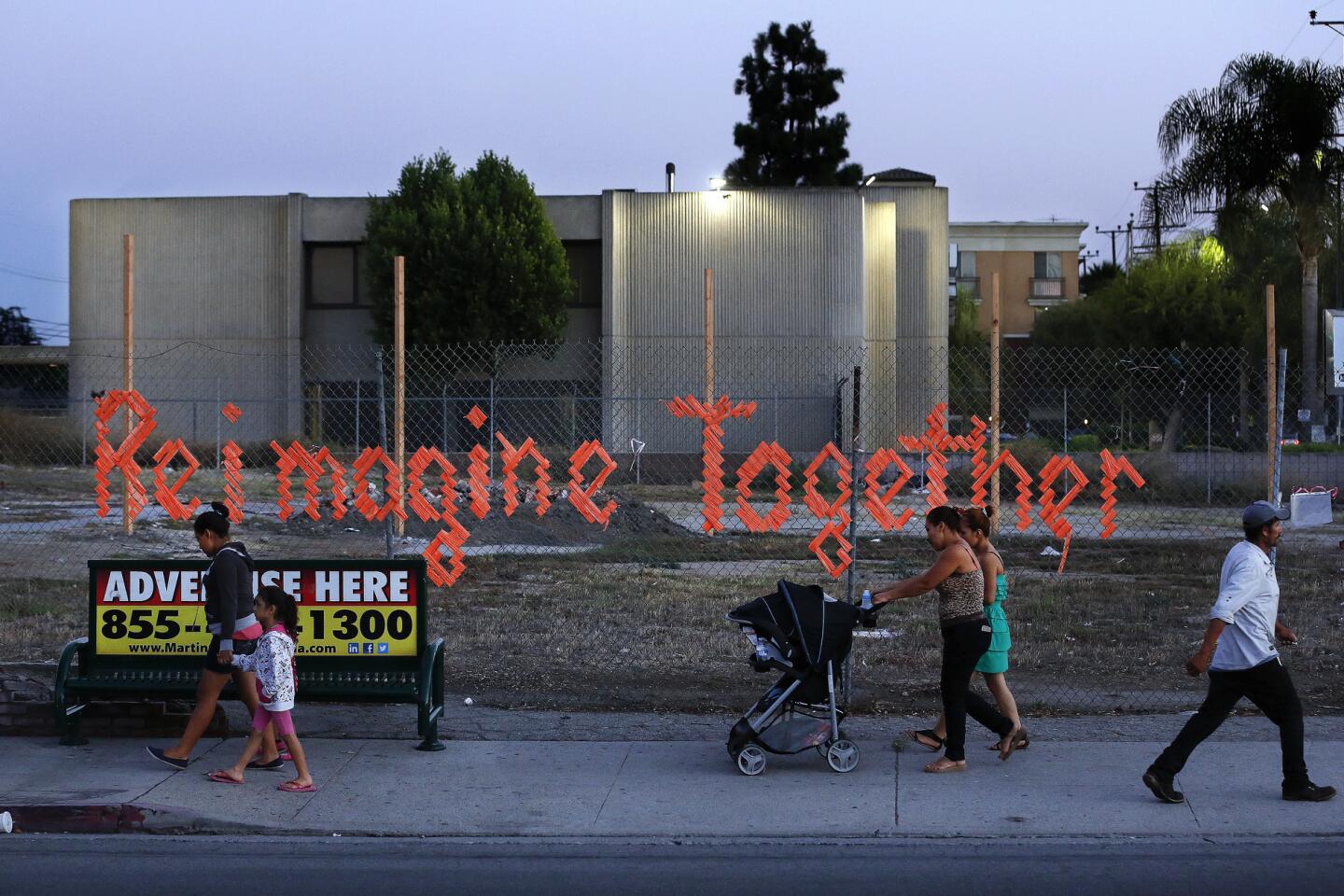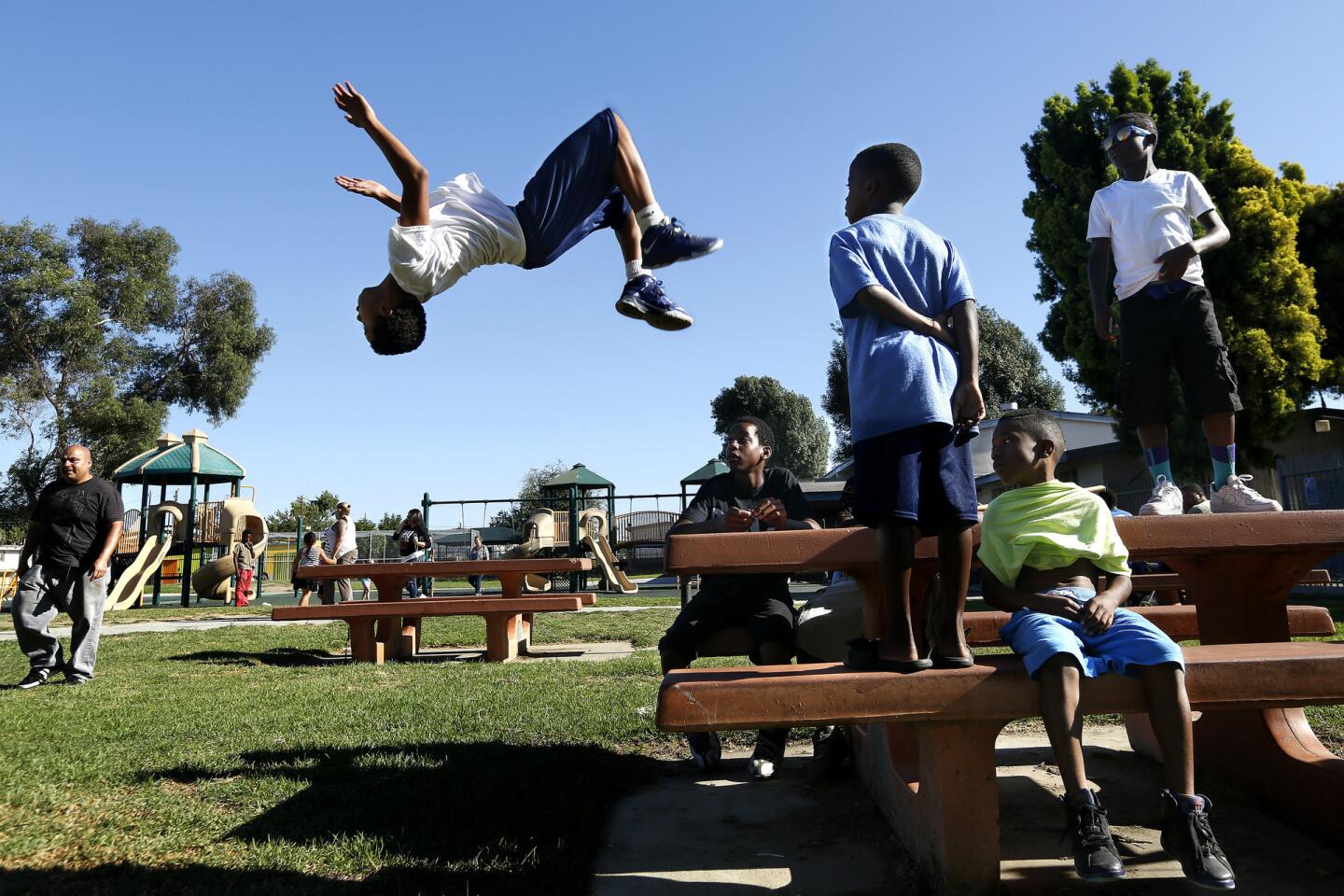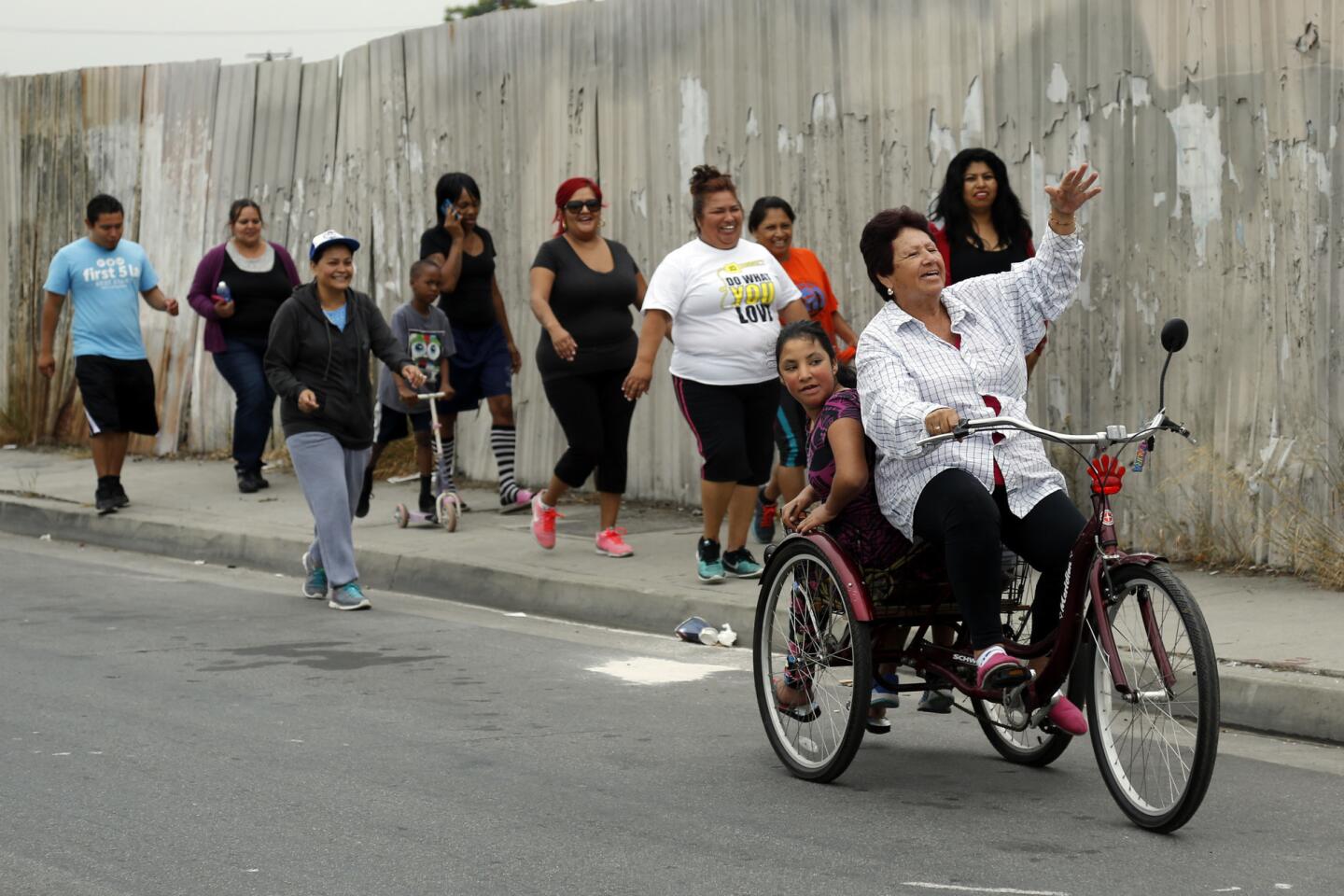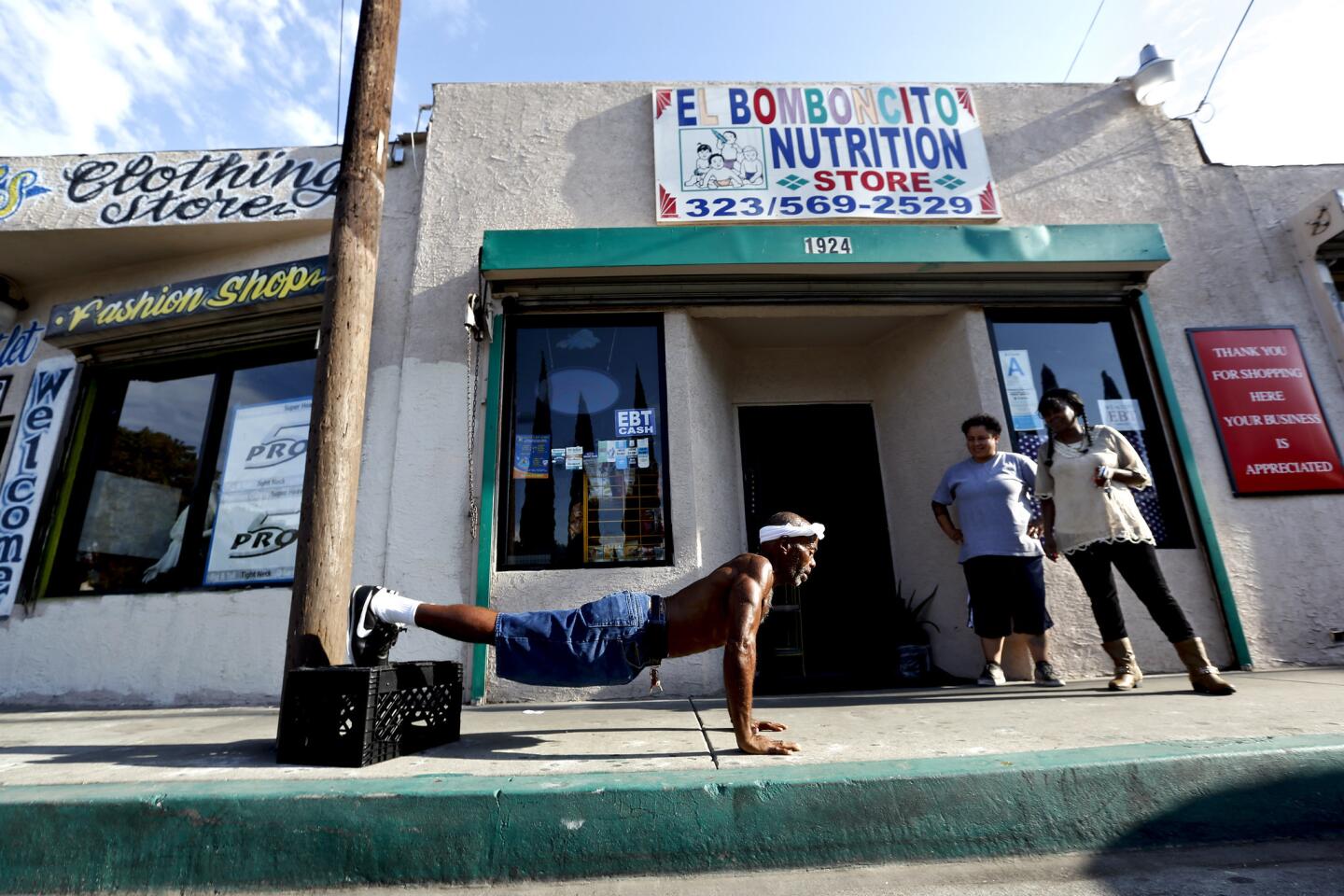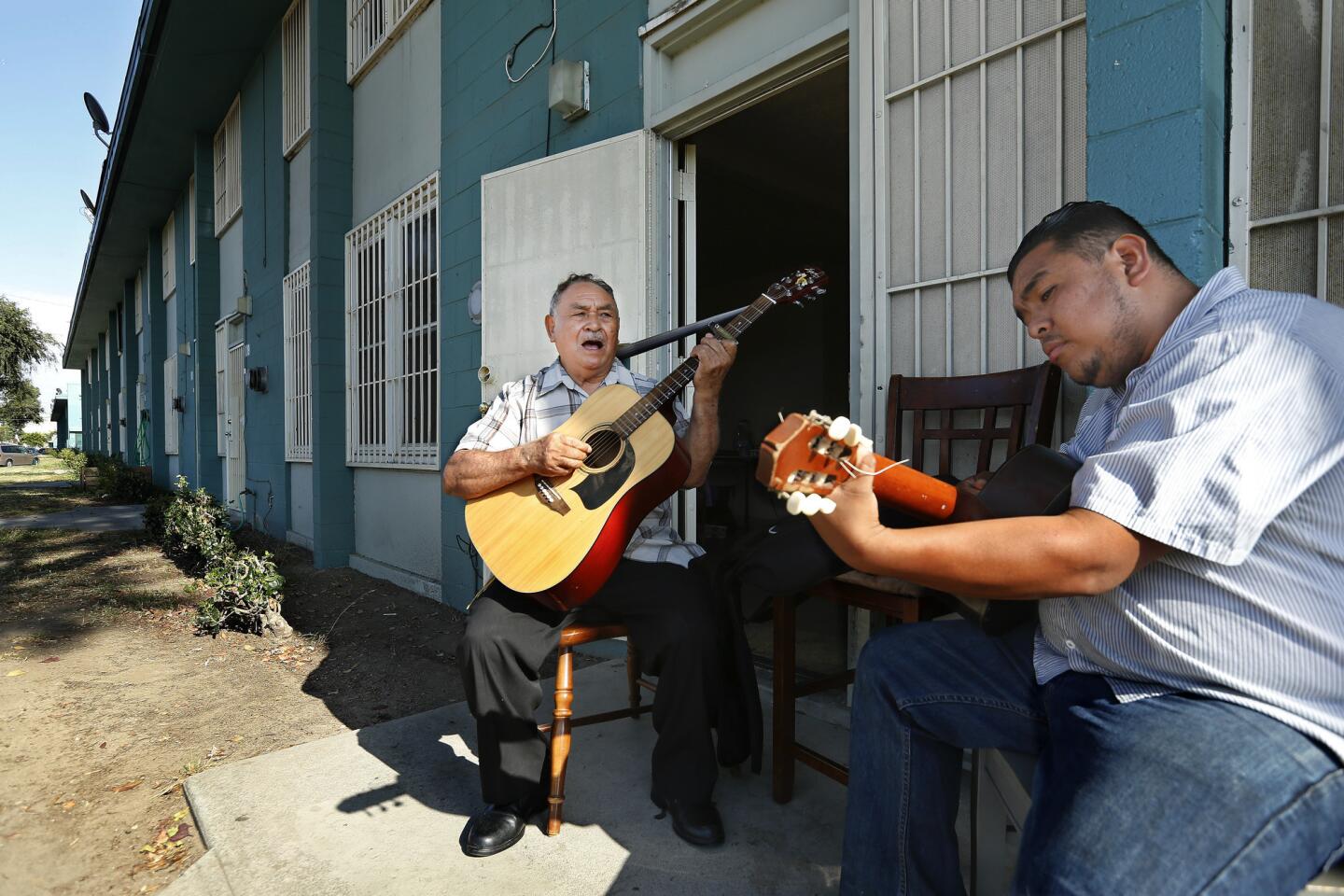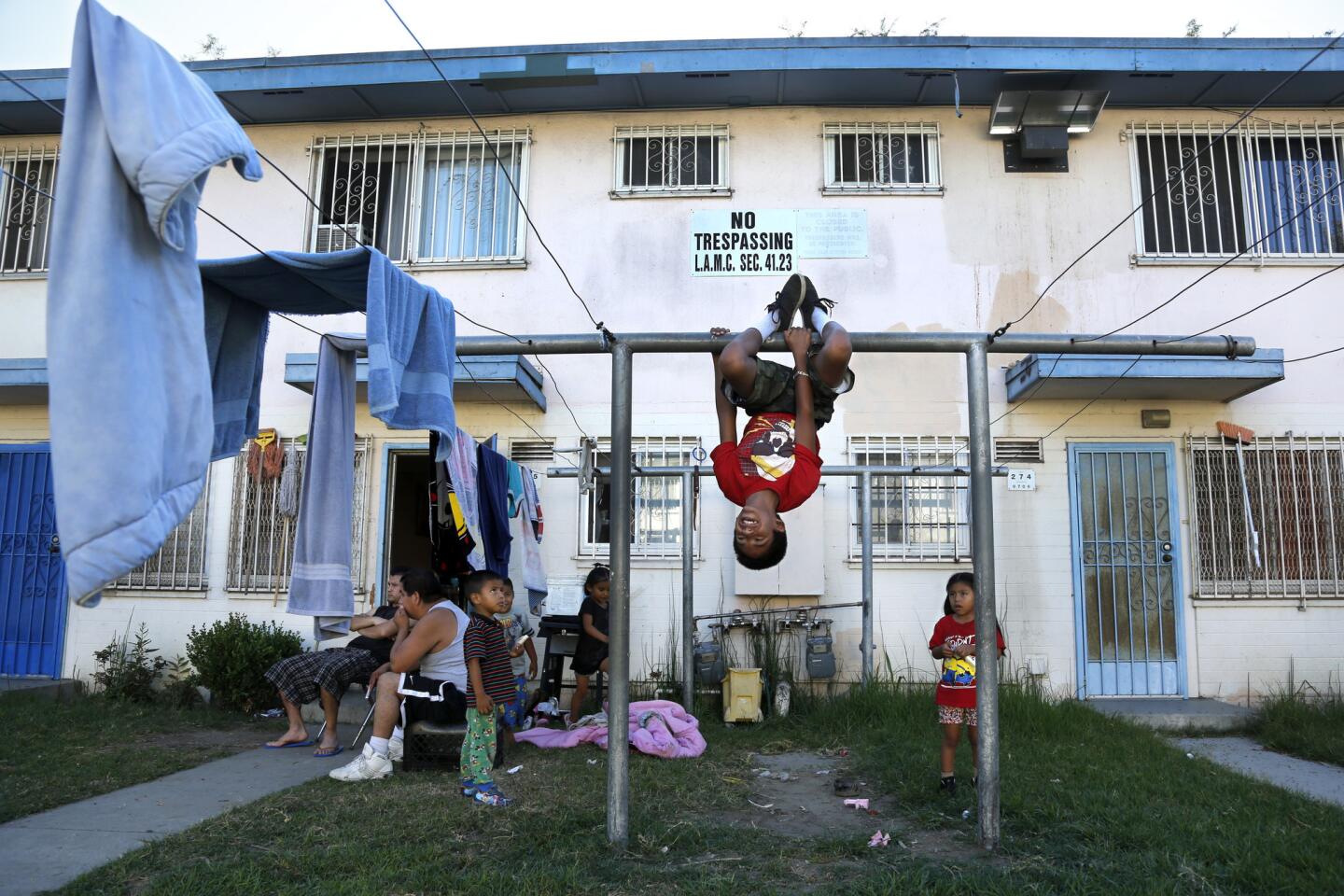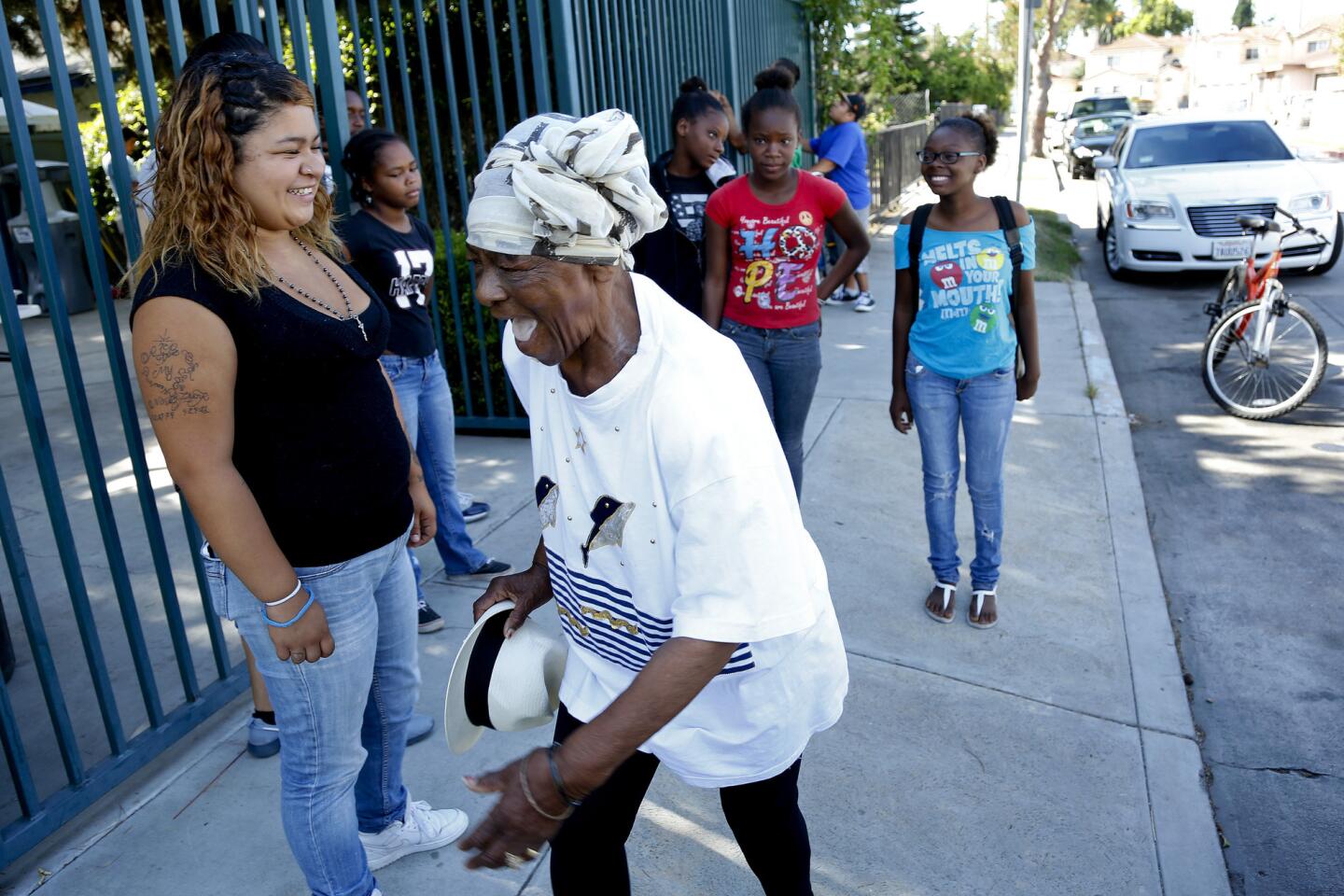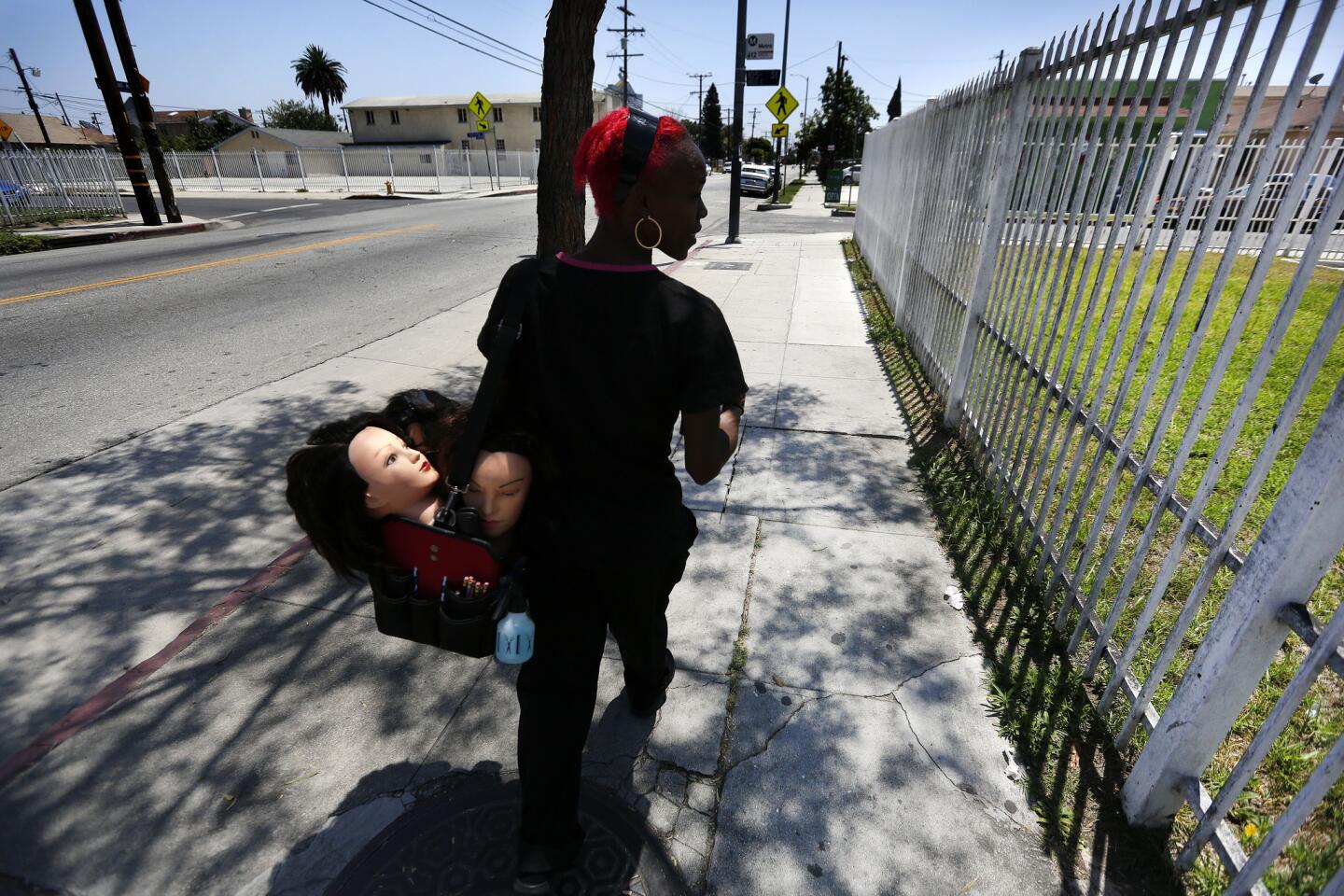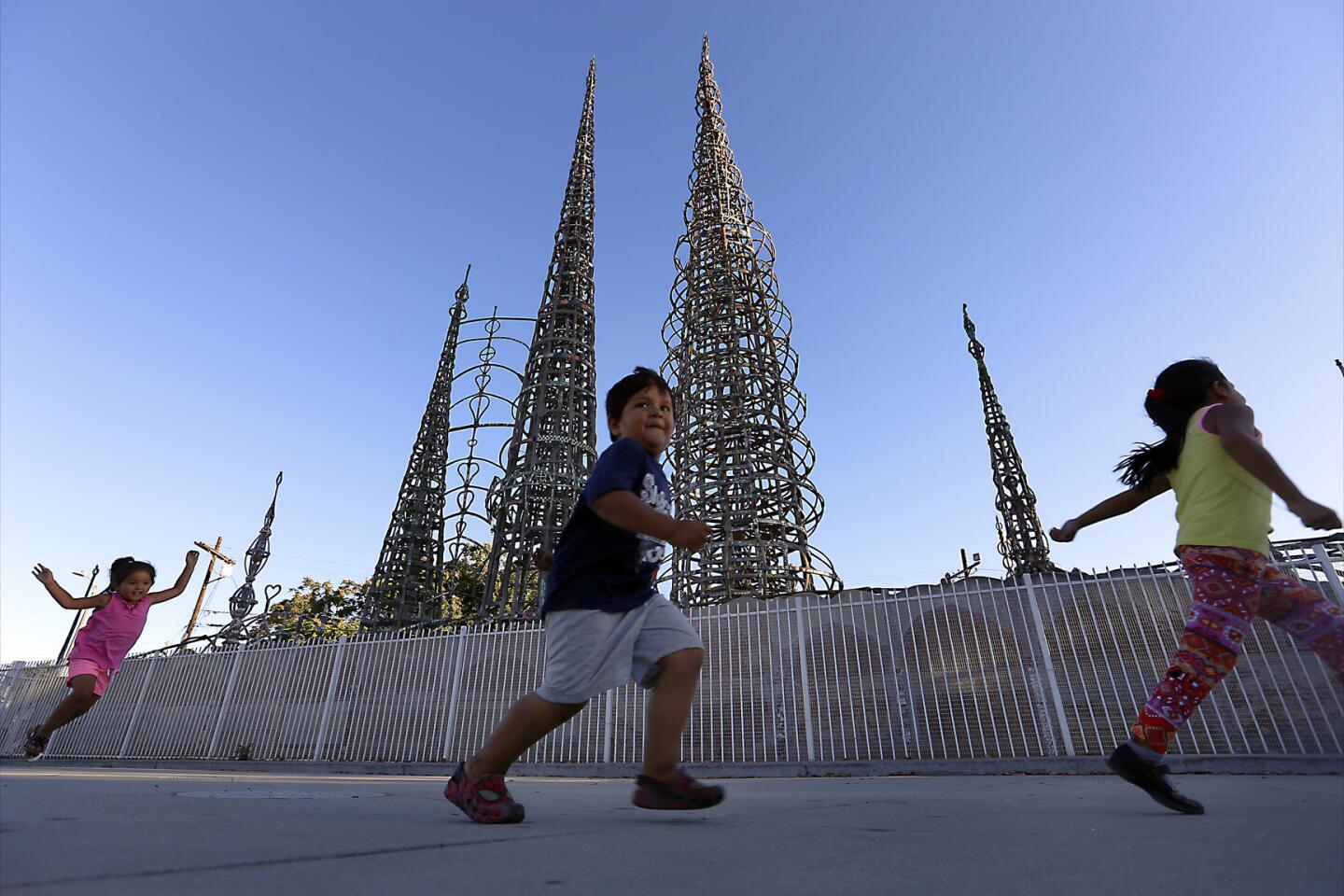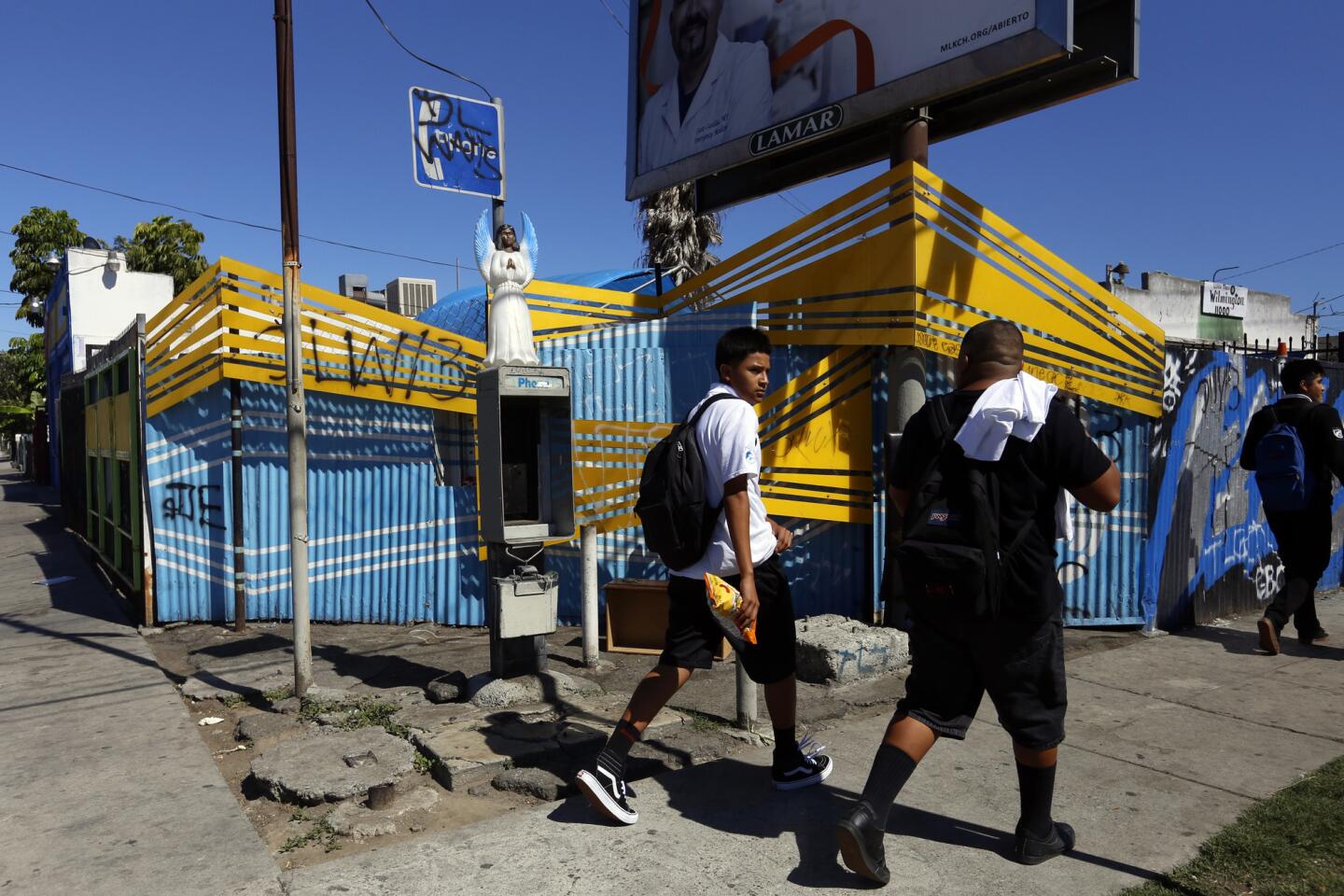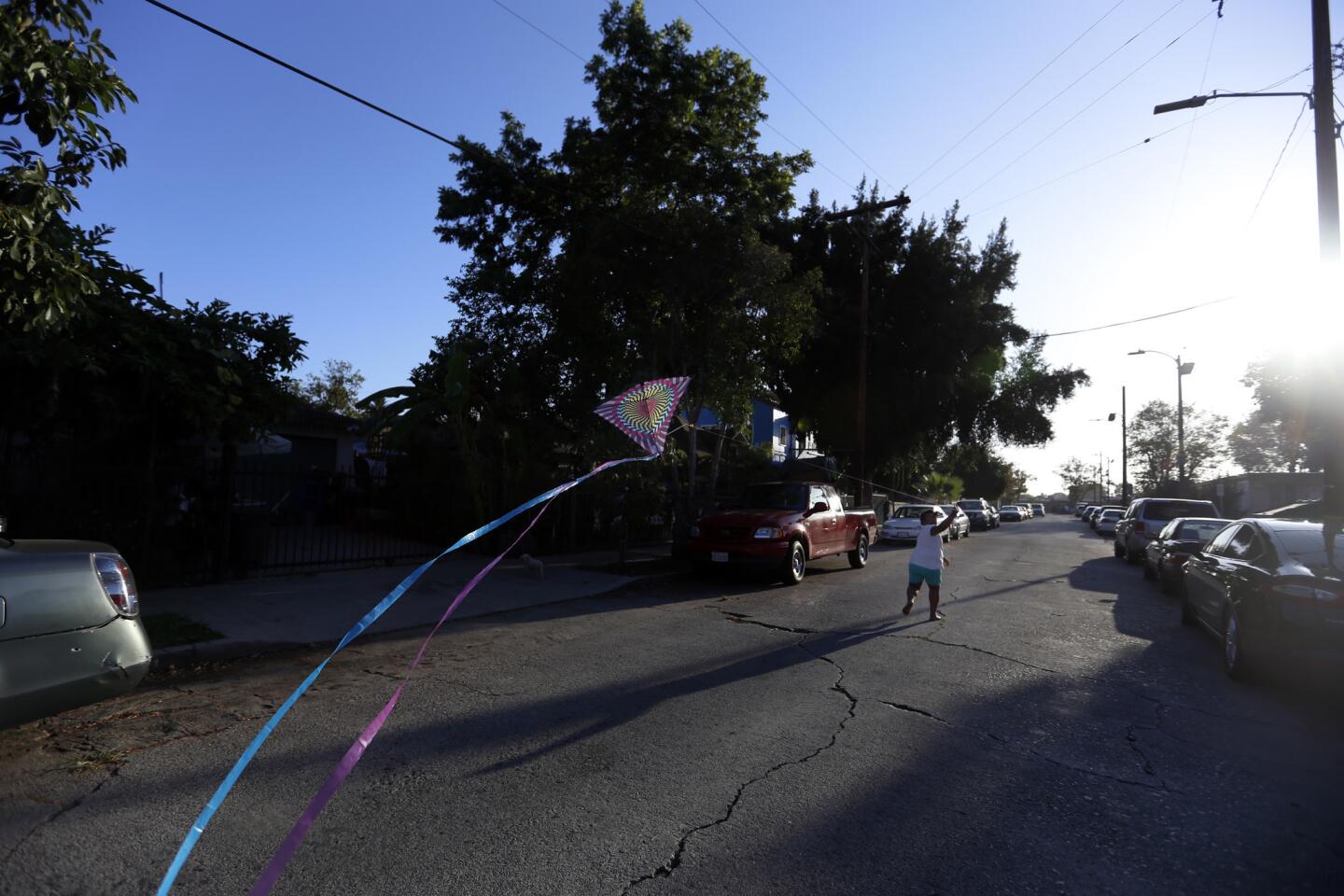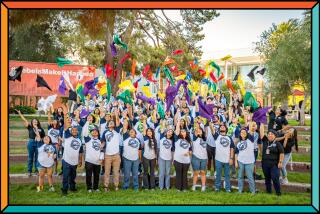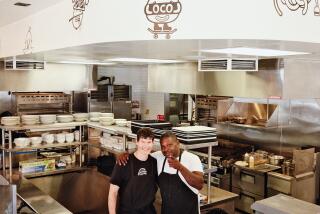Latinos now dominate Watts, but some feel blacks still hold power
The women set out on a brisk walk every Friday morning — past broken bottles, graffiti, an occasional stray dog and the smell of marijuana.
They circle the rim of their home, the Jordan Downs housing project, not just for the sake of exercise but to show the world that Watts, these days, is brimming with Latinos.
“We want people to know we’re here,” said Amada Valle, 58. “And it’s time for our voice to be heard.”
Fifty years ago next week, when rioters set Watts on fire, the neighborhood was nearly all black. Today, Latinos make up more than 70% of the population.
They fill schools, churches and clinics, and their colorful minimarkets dot the streets. Yet for all of Latinos’ presence, their political power remains nearly nonexistent. Just about every organization, committee and board is headed by African Americans. When the Christmas parade marches down Central Avenue, it features high steppers and gospel singers, never folklorico dancers or charros.
Watts, in the view of many outsiders, is still black, even decades after many black families left for the Inland Empire and the high desert in search of better lives.
“It’s like we’re a phantom community,” said Maricela Bañuelos, a resident of 16 years. “No one knows or cares to know we’re here.”
Blacks felt the same way on Aug. 11, 1965. An angry crowd gathered after the California Highway Patrol stopped a driver on suspicion of drunk driving. Violence broke out and spread swiftly, sowing destruction across South Los Angeles.
Police and National Guard troops enforced a curfew for a 46-square-mile section of the city, but they could not end the uprising. By the time it subsided six days later, 34 people were dead, more than 1,000 were injured, and 200 buildings were destroyed.
In 1965, the McCone Commission, appointed by Gov. Pat Brown to determine the cause of the riots, warned that the needs of Latinos should not be overlooked. They suffered “from similar and in some cases more severe handicaps” than the black community, the report concluded.
Today in Watts, the two groups vie for the most basic necessities.
“We compete for the tiniest pieces of the pie,” said Cynthia Gonzalez, an anthropologist raised in Watts. “Instead, we should be asking: Where is the rest of the pie that was promised? Where are the jobs, the quality education, the youth programs and the shopping options?”
Nearly 40% of residents in the neighborhood live below the poverty line, and 50% have less than a high school degree. The population is also relatively young, with almost 40% under the age of 18.
Of the four elected officials who represent the area at the city, state and federal level, two are white and two are black. The four housing developments are primarily run by all-black boards.
Why Latinos have so little power is a complex, sensitive topic in the neighborhood, which saw its demographics shift rapidly in the 1990s.
Some say that black leaders are reluctant to share control of Watts, a historic battleground symbolizing the black struggle.
Black political influence was hard won and became part of a legacy, said Manuel Pastor, director of the Center for the Study of Immigrant Integration at USC.
By contrast, Latinos include many immigrants who aren’t eligible to vote and are relatively new to local politics, Pastor said.
Latinos aren’t lining up to lead. It’s tough to get them to even show up for community meetings.
Most have no notion of the uprising. It predated their arrival. They think riots, they think Rodney King.
They keep busy, just trying to get by, said Rep. Janice Hahn, whose district incudes Watts. Efforts to empower Latinos are often stymied by day-to-day needs like keeping their kids in school and holding down two and three jobs, she said.
“Survival is their priority right now.”
::
When someone wants to hear from Latinos in Watts, they often turn to Arturo Ybarra.
The former factory worker, who said he was once tortured by the Mexican government for his college activism, moved to the neighborhood in the 1970s.
He wanted Latinos to be more involved. So in 1990, when the population was close to 50%, he founded the Watts Century Latino Organization.
Ybarra aimed to fill many voids: literacy classes, financial education, computer access, crime prevention, job training.
He took on big battles, suing the Housing Authority in 1996 for poor living conditions in Watts’ housing projects. Most of those affected were Latino.
After 25 years working in the neighborhood, he said, his relationship with black leaders is a mixed bag.
Ybarra said support from the biggest social services organization formed after the riots, the Watts Labor Community Action Committee, has been “up and down.”
“What we need is consistent help, but all we’ve gotten are leftovers,” Ybarra said. “How do you expect a Latino leadership to grow out of this within a period of 15 to 20 years?”
His organization is based in a former liquor store that once crawled with drugs and prostitution. It is a revolving door for Latino families: Mothers show up with bullied children, men seek immigration advice, youths inquire about summer programs.
“You’re our Cesar Chavez,” Mery Alvarez told Ybarra on a recent morning as he spoke at a health workshop beneath a tent in the parking lot.
At 71, Ybarra knows he doesn’t have much time left. He said that the immigrant community he serves steps up in small ways — neighborhood watch groups, church gatherings, exercise classes — but that more is needed to bring about civic change.
His bright-orange offices show the results of battles waged and lost from money running dry: the computer lab, now empty, with the machines collecting dust; in the back, an abandoned after-school program. This year, he had to sell part of his land to keep from closing down.
Still, Ybarra said, he’s driven by hope.
“The good news is we’re still here.”
::
Bilingual signs are posted throughout offices at the Watts Labor Community Action Committee. Some workers have picked up Spanish, including President and Chief Executive Tim Watkins, who is black.
The organization was launched by his father, Ted Watkins, in the aftermath of what many call the Watts rebellion — a term they say conveys the motivation behind the uprising as a revolt against oppression.
Today, the WLCAC is the Ikea of social services in South L.A.
It operates on a $15-million budget, and its 7-acre campus in the heart of Watts offers a mix of services — tax preparation, child care, anger management classes, after-school programs, prisoner reintegration.
There is also a civil rights museum, an art gallery and a large reception hall.
As the demographics of the community have changed, Watkins has worked to bring Latinos into the fold. He plans to add a Cesar Chavez exhibit to the museum and feature some of the community’s best tamales and tacos in upcoming cultural shuttle tours.
Still, the WLCAC’s staff reflects the Watts of nearly three decades ago — 63% are black and 31% are Latino. Only three of its 13 board members, who are elected by the employees, are Latino.
How demographics might change this deep-rooted organization is a difficult question, Watkins says. He can’t ask longtime black employees to leave so he can hire Latinos.
“This ship is huge, and it doesn’t just turn over night,” he said. “But it is turning.”
As that shift plays out, Watkins said, he cautions Latino leaders to “be careful about celebrating your arrival on the scene.” He hopes they acknowledge and learn from the black experience.
“Don’t fail to recognize that when you stand, you’re standing on the shoulders of someone that in many cases was here before,” he said.
And rather than focus on the needs of one group, it’s better to look at Watts as a whole.
“We have commonalities, far more than differences,” he said.
::
Cynthia Gonzalez, the anthropologist, was a baby when her parents, Javier and Maria, began to venture into Watts in the 1980s.
The gardeners found work with a nice, elderly black woman named Mrs. Covington who owned a house on 110th Street.
After she died, the couple bought her home. They remember the neighborhood was nearly all black then and relatively peaceful, aside from a few burglaries.
Things changed when Latino immigrants moved in during the 1990s. Turf battles ignited years of violence.
Gonzalez grew up in a home with a tall iron fence that did little to block the bullets that flew in even in the middle of the day.
Her parents taught her to never focus on skin color. They notified police about Latinos and blacks alike who broke the law.
“Watts was a place where we were all struggling,” Gonzalez said. “People come here seeking a better life, but they lack the basic needs that every human being deserves.”
The King Drew High School graduate was determined to do something about it.
In 2013, she based her doctoral dissertation on the neighborhood. She teamed with the local City Council member and other leaders to produce a 136-page study that explained the needs of the community.
The results mirror much of what was said by the McCone Commission. Except this time, the population was nearly three-quarters Latino.
Gonzalez, an assistant professor in urban health at Charles Drew University, still lives in the family home a few blocks from the campus. Last year she joined the Watts Neighborhood Council. Some residents would like to see her become president; they consider her a fresh, emerging voice.
But Gonzalez, 31, is still trying to determine where she will be most effective.
She sees progress in Watts: The empty lot near where her uncle was killed by gangsters during a quinceañera is now a well-manicured skate park; the barber shops bustle with a mix of black and Latino customers; the Eastside Riders, a black and Latino bike club, helps fix kids’ bikes each week at Ted Watkins Memorial Park.
Systemic change, however, is not something Gonzalez believes she will see in her lifetime.
“That can only happen when local residents partner with elected officials and private investors to really respond to the needs of the people,” she said.
Until then, her plan is to connect with other young, driven Latinos and build a network of leaders.
Gonzalez hopes to use the 50th anniversary of the riots as a teaching moment.
She wants to host a festive Day of the Dead event in November to honor those who died during the six days of violence.
“The more we know about our histories,” she said, “the better we’ll understand where we’re headed.”
::
Ask Latinos why a leadership gap exists in Watts and you’ll probably get one of the following responses:
There’s no pay. No time. We don’t speak English. We’re not documented. We’re outnumbered. Black leaders are intimidating. Our voice won’t be heard. There won’t be results.
Or, as shop owner Esperanza Geraldo said of the Latino families who have visited her carniceria for more than a decade, “They’re just trying to live inside their homes and stay safe.”
Amada Valle, who speed-walks each Friday around Jordan Downs, spends each day encouraging women in Watts, telling them, “Sí, se puede!” (Yes, we can.)
“Let’s get rid of that attitude, of those barriers,” Valle said. “It feels good to be recognized, to walk down the street and know people can count on me and I can count on them.”
The mother of six eases into her living room sofa and reaches for a binder. It’s packed with certificates she’s earned from years of community outreach.
She participates in peace walks, health training, gang prevention, English classes, cultural events. One of her mentors is longtime Watts activist Betty Day, who is black.
Two years ago, Valle joined the Latino Leadership Training Institute, an effort led by Arturo Ybarra and the Urban Peace Institute to develop leaders from residents of the housing developments.
In February, Valle was elected vice president of the Jordan Downs Resident Advisory Council. This is the first time the board of the 700-unit development is majority Latino. Every other housing project board in Watts is all black, though Latinos in those developments now make up about 70% of the population.
Valle attends every meeting, passes out water and occasionally, when people get impatient, urges them in Spanish and broken English to not give up.
That includes her Jordan Downs council president Laura Padilla, who’s still trying to settle into her role as a leader.
“I’ve quit a lot in my life, like high school and some good jobs,” Padilla said. “This is a challenge for me to stay involved.”
As the two join the group of women on their morning walk, they reach the eastern edge of the housing project. The soil is being prepped to make way for a shopping center and the expansion of Century Boulevard. The project is part of a $700-million plan to redevelop the housing community.
“Look, they’re making progress,” Liliana Rodriguez says, looking through the chain-link fence. “For years, they’ve been promising this, and finally we’re seeing it happen.”
The women nod in agreement. They try to envision what this new piece of Watts will look like.
“You see,” Valle tells them. “We can’t stop believing. Change is going to happen.”
[email protected]; [email protected]
Twitter: @palomaesquivel; @LATBermudez
Times staff writer Sandra Poindexter contributed to this report.
THE WATTS RIOTS REMEMBERED: Full coverage of the 50th anniversary
Steve Lopez: Eyewitness to Watts riots won’t give in to discouragement
Patt Morrison: Before Watts ‘65: A black cop’s view of the LAPD
More to Read
Sign up for Essential California
The most important California stories and recommendations in your inbox every morning.
You may occasionally receive promotional content from the Los Angeles Times.
